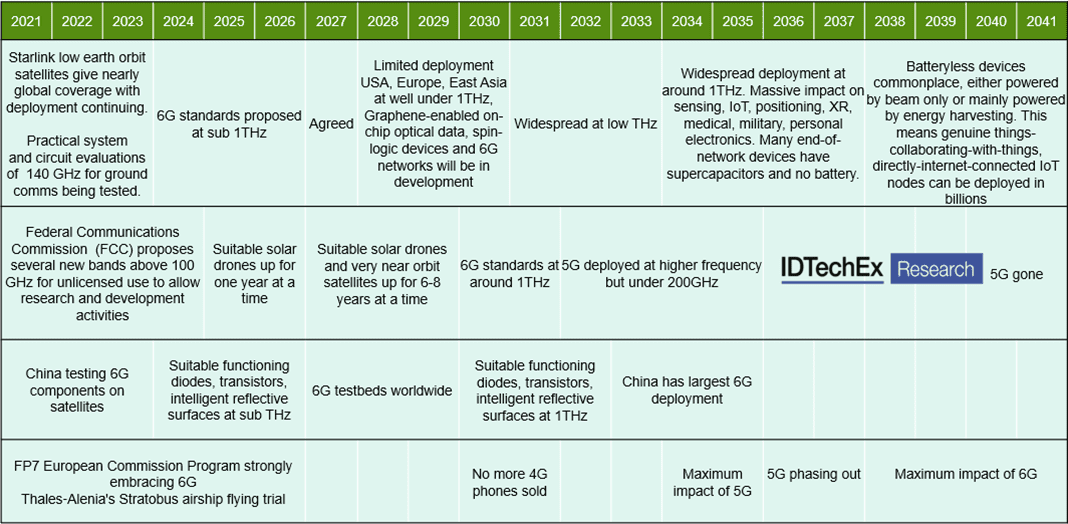(Am I really going to write this?) 6G is a trillion dollar opportunity, apparently. So says the headline in a PR missive about a new report from research firm IDTechEx, making a stab at forecasting the next generation of mobile comms, even before the newest generation has learned to walk – let alone talk. “Far better than 5G,” the message goes; “the race is on”, it says, making out like 5G will be to 6G what 3G was to 4G: a curtain raiser for the real spectacle.
The release talks of the kind of timeless and limitless communications that will transform society by animating intelligent transport systems, lights-out industrial operations, and smart cities. “5G serves far more than the needs of mobile phones or even personal electronics in general. This will be even more true of 6G, with thing-to-thing communication possibly more important than human communication,” it goes.
This will come to pass, we are informed, because 6G will perform “at least 10-times better than 5G” – largely because the Terahertz frequencies it will occupy will be 10 times higher. “There are more things than people in the world… At a minimum, the basic specifications will embrace the needs of sensing, positioning, edge computing, highest definition imaging, and yes, communication.”
All of which sounds like 5G-proper, as it has been sold to the world – an ultra-reliable low-latency comms (URLLC) technology that delivers the kind of sci-fi use cases that will prop-up industrial revolution. We have written this before, of course. “5G will do the boring stuff first”. That is a quote from two years ago, from Ciena, speaking at a Huawei event. The networking pyrotechnics that will fire the industrial sector into a new gear will come much later.
This is still the case. All the talk of private 5G for Industry 4.0; anyone selling private wireless in a serious fashion is still selling LTE networks, sometimes 5G-compatible, but mostly not 5G-anything. Scratch (hardly) beneath the surface, and most 5G engagements with industry are tucked away in corners, geared towards experimentation. Even in live production scenarios, critical industrial machines and processes are not let anywhere near 5G, yet.
We have mentioned it before, in passing; despite the rising hysteria around industrial 5G, the Industry 4.0 movement is effectively locked into a weird standoff between chip vendors and device makers, as if each side is waiting for the other – so supply follows demand, and demand follows supply. And in between, the 3GPP release schedule, carrying crucial industrial 5G upgrades, is being pushed back. So, the industry’s hunger is building but nothing much is cooking at all.
As per the 2018 report, there is a creeping sense that the first wave of 5G services will transform neither the industrial landscape, controlling most of the wider economy, nor the telecoms industry itself. As this wave crashes, and rolls away, the telecoms market will still be serving subscribers with airtime. Industrial upgrade cycles – 30 years for machines, versus 10 years for cars, two for phones – mean Industry 4.0 will miss the ride.
This grim logic says, past 2030, the boat will still be in the harbour. Which begs the question: is 5G just a proving ground for 6G, like UMTS was for LTE? Will it take a decade for the whole Industry 4.0 thing to finally catch sail? Maybe, then, we should write about 6G, with its promise of 100 Gbps data rates, 100-times capacity, sub-1ms latencies, and ‘seven-nines’ (99.99999 percent) reliability?
Except, it turns out, the clank-and-boom of industrial-grade hype hangs about 6G, as well. The most interesting section of the IDTechEx release was about the inherent difficulties to bring a new 6G system to life. “6G cannot happen without something that does not exist and may never be affordable,” it says. How so? Because 6G is pegged for the “cowboy territory of physics”, way up in the ‘far infrared’ terahertz band, from 275GHz up to 10THz.
“They call it the ‘Terahertz Gap’,” explains IDTechEx. “THz beams are narrow, weak, and do not go round corners. Almost anything stops them, so you need ‘smart surfaces’ – ‘hypersurfaces’, ‘intelligent reflective surfaces’, ‘software-programmable metasurfaces’ – to provide access everywhere. [These] consist of active THz metamaterials in separately-programmable ‘tiles’ [to variously] manipulate those THz beams.”
More than this, IDTechEx explains 6G-theory runs counter to the prevailing digital model, that the world solves its problems with less infrastructure (“no more telephone exchanges, no more parking meters”). “[But 6G] needs a huge amount of infrastructure,” it explains. Looking at it this way, everything they say about 6G seems wrong.
“They say 6G will at last permit billions of [interconnected and internet-connected] ’things’, [but that is] the basic concept of IoT. They say 6G is the future of mixed and virtual reality, medical imaging, and robot vehicles. [But] Tesla develops autonomous vehicles that work without mapping or connectivity. It does not need 6G for that.”
So where does that leave us? Where does it leave the big talk of digital change and industrial revolution? Well, it is definitely a thing, this proposed new “thing-to-thing” network system. “Work began in earnest in 2020 with over one billion dollars committed and a Chinese satellite sent up to experiment on the possibilities.” IDTechEx references work in Finland, Korea, China, and India. Finland has $350 million in European Union research grants.
Experiments are taking place already at the easier 100-300GHz end of the Terahertz Gap. The FCC has proposed formalizing an “experimenter’s play area” in some bands between 116GHz and 246GHz. It writes: “So this is serious. Although little is decided – not even the frequency – much can be said about the extremely ambitious 6G objectives and challenges.”
IDTechEx says 6G will overlap with 5G from 2030, and usurp it as the dominant cellular technology from 2037. Its $1 billion revenue figure is based, as well, on the market for metamaterials and compounds in all of those ‘smart surfaces’. It comments: “How do we forecast at this very early stage? You take the 5G forecast and move the dates forward by eleven years. The overlap of 5G and 6G functionality will be considerable – at least seven years.”


